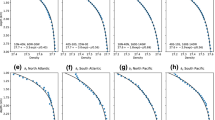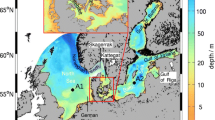Abstract
A three-dimensional sigma coordinate numerical model with wetting and drying (WAD) and a Mellor–Yamada turbulence closure scheme has been used in an idealized island configuration to evaluate how tidally driven dynamics and mixing are affected by inundation processes. Comprehensive sensitivity experiments evaluate the influence of various factors, including tidal amplitudes (from 1- to 9-m range), model grid size (from 2 to 16 km), stratification, wind, rotation, and the impact of WAD on the mixing. The dynamics of the system involves tidally driven basin-scale waves (propagating anticlockwise in the northern hemisphere) and coastally trapped waves propagating around the island in an opposite direction. The evolutions of the surface mixed layer (SML) and the bottom boundary layer (BBL) under different forcing have been studied. With small amplitude tides, wind-driven mixing dominates and the thickness of the SML increases with time, while with large-amplitude tides, tidal mixing dominates and the thickness of the BBL increases with time. The inclusion of WAD in the simulations increases bottom stress and impacts the velocities, the coastal waves, and the mixing. However, the impact of WAD is complex and non-linear. For example, WAD reduces near-coast currents during flood but increases currents during ebb as water drains from the island back to the sea. The impacts of WAD, forcing, and model parameters on the dynamics are summarized by an analysis of the vorticity balance for the different sensitivity experiments.













Similar content being viewed by others
References
Beckmann A, Haidvogel DB (1993) Numerical simulation of flow around a tall isolated seamount. Part I: problem formulation and model accuracy. J Phys Oceanogr 23(8):1736–1753
Chen C, Huang H, Beardsley RC, Liu H, Xu Q (2007) A finite volume numerical approach for coastal ocean circulation studies: comparisons with finite difference models. J Geophys Res 112:C03018. doi:10.1029/2006JC003485
Ezer T, Liu H (2009) Combining remote sensing data and an inundation model to map tidal mudflat regions and improve flood predictions: a proof of concept demonstration in Cook Inlet, Alaska. Geophys Res Lett 36:L04605. doi:10.1029/2008GL036873
Ezer T, Mellor GL (1994) Diagnostic and prognostic calculations of the North Atlantic circulation and sea level using a sigma coordinate ocean model. J Geophys Res 99(C7):14159–14171
Ezer T, Mellor GL (2000) Sensitivity studies with the North Atlantic sigma coordinate Princeton Ocean Model. Dyn Atmos Ocean 32:185–208
Ezer T, Arango H, Shchepetkin A (2002) Developments in terrain-following ocean models: intercomparisons of numerical aspects. Ocean Model 4(3-4):249–267
Ezer T, Hobbs R, Oey LY (2008) On the movement of Beluga whales in Cook Inlet, Alaska: simulation of tidal and environment impacts using a hydrodynamic inundation model. Oceanography 21(4):186–195
Heniche M, Secretan Y, Boudreau P, Leclerc M (2000) A two-dimensional finite element drying-wetting shallow water model for rivers and estuaries. Adv Water Resour 23(4):359–372. doi:10.1016/S0309-1708(99)00031-7
Ioualalen M, Asavanant J, Kaewbanjak N, Kirby ST, Watts P (2007) Modeling the 26 December Indian Ocean tsunami: case study of impact in Thailand. J Geophys Res 112:C07024. doi:10.1029/2006JC003850
Jiang YW, Wai OWH (2005) Drying-wetting approach for 3d finite element sigma coordinate model for estuaries with large tidal flats. Adv Water Resour 28(8):779–792. doi:10.1016/j.advwaters.2005.02.004
Kamiya M, Hiramatsu K, Harada M, Mori M (2006) A three-dimensional sigma-coordinate ocean model with a wetting and drying scheme and its application to Isahaya Bay. Sci Bull Fac Agr, Kyushu Univ 61(2):289–296
Mellor GL (1996) Introduction to physical oceanography. American Institute of Physics, Woodbury, p 260
Mellor GL (2004) User’s guide for a three-dimensional, primitive equation, numerical ocean model. Program in atmospheric and oceanic sciences. Princeton University, Princeton, p 56
Mellor GL, Yamada T (1982) Development of a turbulent closure model for geophysical fluid problems. Rev Geophys 20:851–875
Mellor GL, Oey LY, Ezer T (1998) Sigma coordinate pressure gradient errors and the seamount problem. J Atmos Ocean Technol 15:1122–1131
Oey LY (2005) A wetting and drying scheme for POM. Ocean Model 9(2):133–150. doi:10.1016/j.ocemod.2004.06.002
Oey LY (2006) An OGCM with movable land-sea boundaries. Ocean Model 13(2):176–195. doi:10.1016/j.ocemod.2006.01.001
Oey LY, Ezer T, Hu C, Muller-Karger FE (2007) Baroclinic tidal flows and inundation processes in Cook Inlet, Alaska: numerical modeling and satellite observations. Ocean Dyn 57(3):205–221. doi:10.1007/s10236-007-0103-8
Sobey RJ (2009) Wetting and drying in coastal flows. Coast Eng 56(5–6):565–576. doi:10.1016/j.coastaleng.2008.12.001
Uchiyama Y (2004) Modeling wetting and drying scheme based on an extended logarithmic law for a three-dimensional sigma-coordinate coastal ocean model. Rep Port Airport Res Inst 43(4):3–21
Westerink JJ, Luettich RA, Feyen JC, Atkinson JH, Dawson C, Roberts HJ, Powell MD, Dunion JP, Kubatko EJ, Pourtaheri H (2008) A basin to channel scale unstructured grid hurricane storm surge model applied to southern Louisiana. Mon Weather Rev 136(3):833–864
Xie L, Pietrafesa LJ, Peng M (2004) Incorporation of a mass-conserving inundation scheme into a three-dimensional storm surge model. J Coast Res 20:282–296
Acknowledgements
The WAD model was originally developed by L.-Y. Oey, Princeton University, with support from the Minerals Management Service (MMS). Additional support is provided to T. Ezer by grants from NOAA’s National Marine Fisheries, NOAA’s Climate Programs, and the National Science Foundation (NSF). S. Saramul is partly supported by the Royal Thai Government.
Author information
Authors and Affiliations
Corresponding author
Additional information
Responsible Editor: Yasumasa Miyazawa
Rights and permissions
About this article
Cite this article
Saramul, S., Ezer, T. Tidal-driven dynamics and mixing processes in a coastal ocean model with wetting and drying. Ocean Dynamics 60, 461–478 (2010). https://doi.org/10.1007/s10236-009-0250-1
Received:
Accepted:
Published:
Issue Date:
DOI: https://doi.org/10.1007/s10236-009-0250-1




